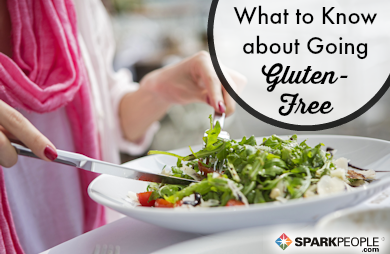In my free time, I like to read healthy living blogs, and one of my favorites is Healthy Tipping Point, which is written by Caitlin, who also writes OperationBeautiful.com. Caitlin is a vegetarian who eats very balanced meals, so I was surprised to learn that she didn't really love
vegetables. As soon as I took a closer look at her meals, I realized why: She was eating them plain!
I issued her the Learn to Love Veggies Challenge. She took up the gauntlet and commenced the vegetable adventure.
Now, it's your turn!
Choose a few of these tips and implement them into your weekly meals. They're all pretty simple and affordable.
1. Add olive oil/lemon/garlic:
Sautéing garlic in a bit of olive oil and adding lemon zest and juice really brings out great flavor. This technique works great with broccoli, spinach, cauliflower, asparagus, sugar snap peas and zucchini.
Try this recipe: Broccoli Everyone Will Love
2. Changing the texture:
Changing the way you cut vegetable can affect how they taste. Try these tips the next time you cook vegetables:
- Slice green beans, asparagus and carrots (fresh or frozen) on the diagonal.
- Shred (using a food processor) or grate sweet potatoes, broccoli stems, and zucchini.
- Thinly slice (using the slicing attachment on a food processor) or using a chef's knife cabbage, broccoli, cauliflower, Brussels sprouts, mushrooms and snap peas.
- Slice or shred lettuce, spinach and other greens.
- It can seem less overwhelming to see a cup of chopped vegetables rather than several really large pieces.
- Purée any cooked vegetable with a bit of vegetable broth or low-fat milk and season to taste for an easy soup or side dish.
Try this recipe: So You Think You Hate Veggies? Green Beans
3. Roasting
This technique works for any root vegetable: potatoes, sweet potatoes, carrots, turnips, parsnips, carrots, butternut and acorn squash, even radishes. You can also roast broccoli, asparagus, cauliflower, mushrooms, onions, okra, and peppers. It's best to roast root vegetables separate from green vegetables as their cooking times will vary.
- Halved Brussels sprouts are particularly good when roasted!
- I like to sprinkle on a favorite spice blend (Cajun or creole, cumin/salt/pepper, Old Bay seasoning, etc.) or dried herbs like rosemary, thyme or oregano.
- Serve with ketchup (sometimes I stir a teaspoon of curry powder into my ketchup--so good!).
- This is a good recipe to use when you're trying new vegetables.
Find details here: The Magical Cooking Technique That Will Get You to Eat Your Veggies Choose one new vegetable this week and roast it!
4. "Cream" sauce
Make your ordinary steamed vegetables a bit more decadent with a bit creaminess. I like to mix light cream cheese, low-fat sour cream (with herbs) or a wedge of Laughing Cow cheese with steamed broccoli, peas or cauliflower.
No-recipe recipe: Try this on your choice of vegetables.
5. "Pancakes" or quiches/frittatas
I saw Caitlin's recipe for broccoli-cheese frittata. That's a great way to get in some vegetables. Try chopped tomatoes or red/orange/yellow peppers next time, too--or a shredded carrot.
- This is a great way to get in your greens. Try spinach, Swiss chard or another green chopped and cooked with eggs. Add onions or peppers for some added flavor.
- I like to make zucchini skillet cakes for dinner. You can also use sweet potatoes (see the recipe's notes on changing the seasonings) or add another kind of squash or carrots, too. These are good topped with a chopped tomato-onion salad drizzled in balsamic vinaigrette.
Try this recipe: Zucchini Pancakes Recipe; this is more like a meal than a side dish.
6. Low-calorie flavor boosters: lemon juice, capers, roasted red peppers, sun-dried tomatoes
Keep some of these ingredients on hand to instantly perk up bland vegetables:
- Lemons (or even bottled lemon juice)--adds zing
- Onions/peppers/garlic--these vegetables are called "aromatics" for a reason. They add flavor and aroma to any dish. Try sautéing any combination of these with your vegetables for a burst of flavor.
- Capers--add a salty burst
- Roasted red peppers--these are sweet and great with green beans, broccoli and cauliflower. Chop them finely or purée with olive oil, salt and pepper for a quick sauce.
- Sun-dried tomatoes--chop a couple and add them to your vegetables as they steam. They'll add a rich, sweet flavor.
- Parmesan cheese--a sprinkle of this will add richness to your vegetables.
- Butter--yes, it's more virtuous to eat vegetables plain, but if a small pat of butter or margarine will increase your enjoyment of your food, then dig in!
- Remember that some vitamins require fat to be absorbed by the body, so including a bit of fat with your vegetables will make them taste better and help your body use their nutrition more efficiently.
Try these: Choose two of these ingredients and add them to your vegetables.
7. Get saucy.
Top your vegetables with your favorite sauces. Choose from:
- Bottled curry sauce
- Spaghetti sauce
- Pesto
- Salsa (particularly good on baked potatoes/sweet potatoes)
- Teriyaki/Asian sauces (I usually make my own from scratch, but you can find some good, low-sodium ones these days)
- Hot sauce
Try this: Choose one sauce to add to your vegetables.
So what did Caitlin think? Well, she learned to love grilled squash and zucchini, roasted potatoes and carrots, and a few others. She especially liked the addition of garlic and olive oil.
Will you take the Learn to Love Veggies Challenge? If you do, send me your thoughts via email (editor@dailySpark.com), and I'll share them in a follow-up post. How do you like to eat your veggies? Do you require coaxing, or do you eat them willingly?
|
|




.png)










